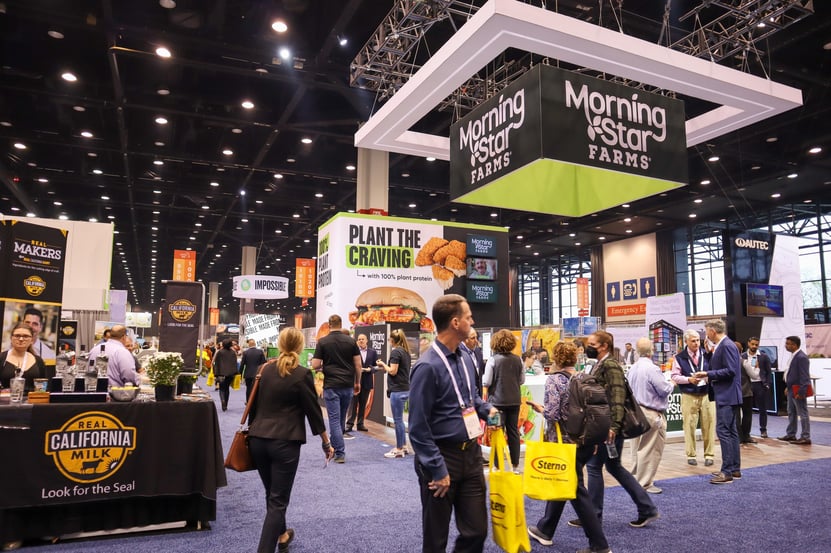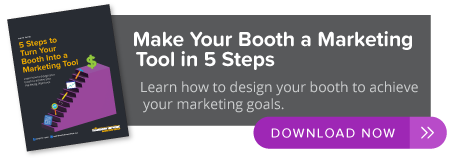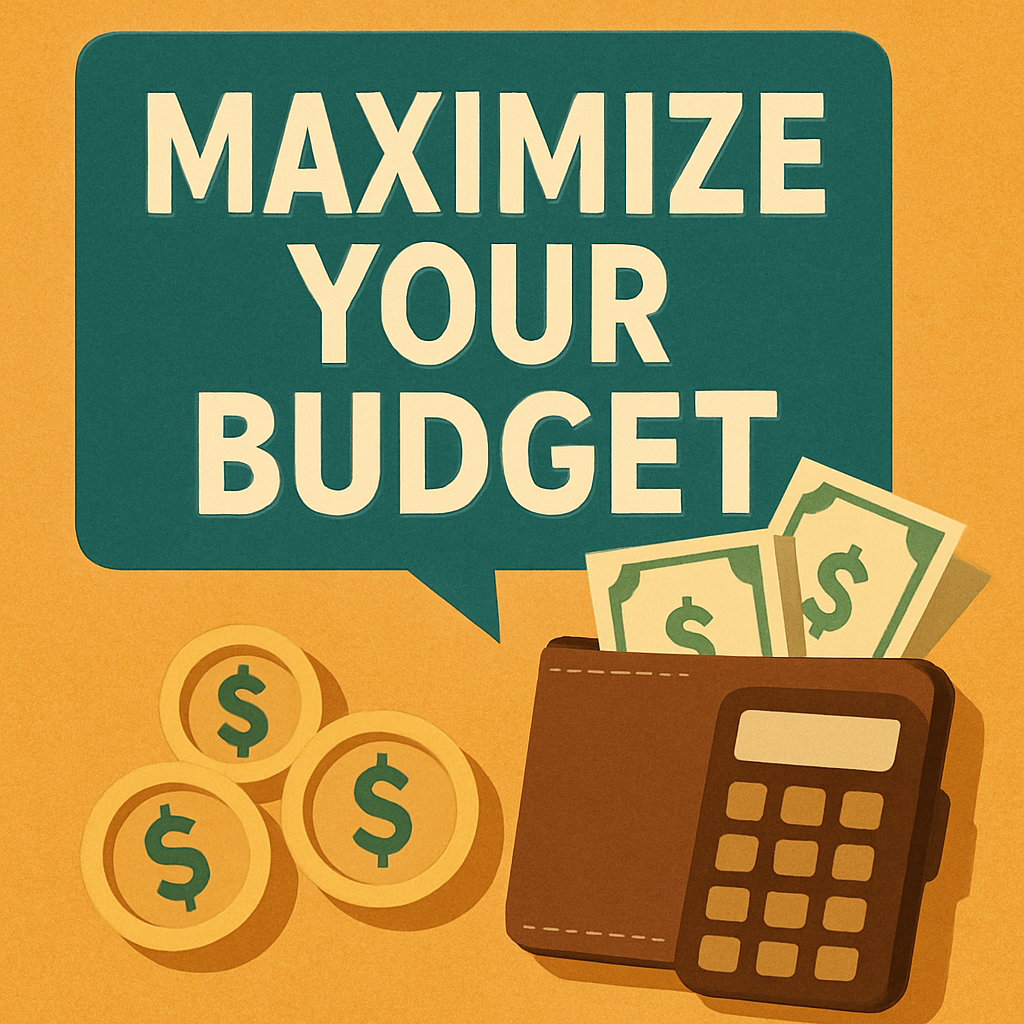Marketing is a term that is often confused with advertising, promotions, publicity, branding, and selling. In fact, marketing can be all of those activities and more that are aimed at helping a business grow. The basic idea of marketing is to create awareness and interest in a company’s products or services. The modern consumer is time-stricken but savvy, with the means to acquire information easily at the touch of computer button or at a trade show event – in your booth. The job of both the event manager and the booth designer is to create the exhibit with marketing to your audience in mind. A marketing-driven trade show booth can get them to see your brand by improving how you communicate to them. This means you need to know who your best prospects are, what product answers their needs, how you can provide the product, and how it can benefit them. In a booth setting, the marketing messages need to be simple, quick and to the point, representing how your company is valuable to them.
Overall you need to design your booth for functionality, which is driven by your marketing objectives. The objectives of a company can vary widely, depending on the products or services they sell, where they are in the marketing life cycle, their audience, and the sales process. Your design can be geared to promote your brand, generate leads, sell through demonstration, presentation, or technology, or hand out samples for the touch-and-feel approach. Whatever your marketing objectives, make sure that the basic functionality of your booth conveys them.
As exhibit designers, we recommend that exhibitors follow the five steps of the trade show exhibit design process, which can save you money on your booth design, as well as headaches and re-work down the road. And with the help of the right creative team and excellent show services support, you are guaranteed to have a great experience and an exhibit solution you love. This simple project plan has demonstrated that it works. To help guide you in the planning process we have also developed a list of exhibit design questions that you need to answer to effectively implement the design process. By answering these questions and following the process you will have an effective booth that draws in the crowd and brings your brand to life!
“Keep in mind that each show has a unique target market, which means you should highlight products or services specific to that audience.”
01. Pre-Planning
Although it is not glamorous, investing the time to answer key questions before you start is critical. Your answers will provide the purity of purpose and message that will drive the overall direction of the design. Think of this stage as an opportunity to identify your objectives for the booth and to narrow the focus to make that design as effective as possible. The more information you provide, the greater your chances that the design solution will exceed your expectations. This phase involves completing the Exhibit Design Planning Questions, which cover your marketing messages, booth functionality and how you will interact with attendees, design considerations for your brand, and budget.
02. Discovery
The discovery phase involves identifying and communicating your marketing purpose, goals and objectives, expectations, timelines, and budget, along with milestones and deliverables. Take a look at your past exhibit designs and determine what worked well and what did not. Go on the internet and research the display designs of your competitors. If you took pictures at your last event, review what others did with their exhibits and identify what you liked and did not like. Flesh out how you will use the booth for the show and your desired results in order to determine the basic structure, functionality and features required in the design. These elements will have a direct impact on costs and timelines, and will provide the foundation for your budget and the design estimate.
03. Design Concept and Rendering
Once the project is properly defined, the design step begins. Based on your preferences for the look, function, and budget for your exhibit, the design team develops several concepts for the exhibit design. The concepts are rendered with different views of how the booth will look in your specific trade show space. You pick the concept you like the best and provide feedback on any desired changes. You are essential to the creative process, as the exhibit designers can explore whatever direction you want. Once you are comfortable with the basic design concept, the design is revised based on any suggestions you have and then a final rendering is provided for approval.
“To realize the greatest return on this investment, the booth must be attractive to attendees and booth staff, flexible enough to support multiple marketing campaigns (if required), and cost-effective to use...”
04. Proposal
Once the design is complete, the next step is to have the exhibit house develop a proposal with all the elements and related costs. The proposal includes such items as graphic sizes needed, booth structure, any rental components, show services, terms and conditions, and detailed pricing for each item. If you are creating the graphic images yourself, you will need to receive a graphic design guideline document that describes the type of files you will need to submit to produce your booth graphics, along with a time frame of when each component must be completed to be ready for the show. Exhibit firms also can provide graphic design services if you prefer. Keep in mind that each show has a unique target market, which means you should highlight products or services specific to that audience. You may want to create unique graphic panels for several of your most important shows.
05. Exhibit Building, Show Launch and Follow-Up
Exhibit Building: Once the proposal has been signed, the exhibit building begins. You will be assigned a project manager and a show services manager who will help you through the process. He or she will work with you by reviewing the deadlines and making sure that you understand the entire process. Some exhibits will take weeks to develop. As the graphic elements are finalized for your booth, you will be sent proofs for approval. Upon final approval and invoicing, the exhibit house can stage the booth for your in-person assessment prior to shipping to a show. Since a trade show exhibit makes a strong impression on potential customers, everyone benefits by making sure everything is in order well before the shipping date and show deadlines.
Your Booth = A Marketing Tool
Designing and building your trade show booth can be one of the largest single trade show expenditures your company will incur and a significant part of your overall marketing budget. To realize the greatest return on this investment, the booth must be attractive to attendees and booth staff, flexible enough to support multiple marketing campaigns (if required), and cost-effective to use in terms of both purchase price and recurring costs such as shipping. By following this planning process, you should be able to develop a high-impact exhibit that moves your marketing goals forward.
Show Launch:
If your exhibit house is providing show services support for your booth, you will be assigned to a show services manager who will assist you inn making sure everything is set up correctly prior to the show and at the show. An onsite manager will be available to you along with telephone
support from the headquarters’ staff to ensure that the event goes smoothly.
Follow-Up:
After the show, your exhibit firm should contact you to discuss how everything went. The shared goal of both exhibit house and exhibitors is to have happy customers! Professional assistance can simplify this process and heighten your brand impact. Please visit The Tradeshow Network Marketing Group’s website to browse options and request design ideas or an estimate for your next exhibit!
Recent news
Subscribe
Sign up for trade show updates here:






